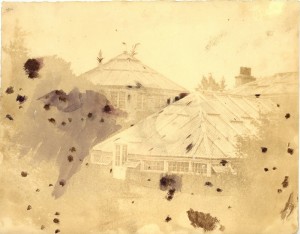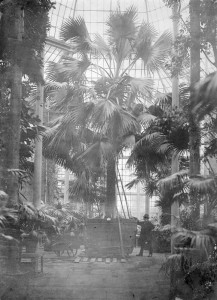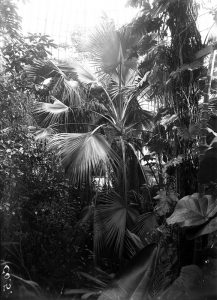The Sabal Palm (Sabal bermudana) is frequently mentioned as being the oldest plant in our collection at about 200 years old. A couple of years ago while researching George Don I looked into tracking down the exact date that the Sabal Palm entered the collection, hoping that it would coincide with the dates that George was Principal Gardener from 1801 to 1806. Unfortunately this is probably not the case but I did dig out some interesting bits of history relating to the Sabal. A joint article on the history of the Sabal at RBGE and details of the horticulture works carried out to secure the future of the palm, written by Paul Mullany an arboriculturalist in the garden, will be published later this year in Sibbaldia.
History of the Sabal

Image of the Octagonal Palm House taken in 1854. Note the Palm fronds breaking through the roof.
Photographer: Dr. Duncan.
Image: Archives of the Royal Botanic Garden Edinburgh
As I said the Sabal is oldest known plant in the collection at RBGE, being on site since 1822. The earliest mention of this date is by James McNab in an account of Sabal umbraculifera in the palm stove at Edinburgh read in 1874 to the Botanical Society of Edinburgh. He noted that the Sabal had arrived at Inverleith in 1822 from Leith Walk and then spent the next 13 years in a lean-to glasshouse. The plant had suffered from the lack of space in the lean-to and was moved in 1835 into the Octagonal Palm House, now the Tropical Palm house, which was constructed a year earlier, where McNab writes that it succeeded well.
In 1858 Professor John Hutton Balfour wrote that the Sabal, and other Palms, had been moved into the new Palm House, now the Temperate Palm House, by James McNab and his team. Balfour estimated that the Sabal and rootball weighed 7 or 8 tons. Then in 1874 James McNab and his team moved the Sabal back into the Octagonal palm house. It was also in 1874 that he estimated the plant’s age as being at least 60 years old.

Image of the Sabal taken in 1874 after its move and ‘retubbing’ by James McNab and his team.
Photographer: ?
Image: Archive of the Royal Botanic Garden Edinburgh
One piece of missing information from the Sabal story is when it was finally planted out of a tub and into the ground. Leonie, RBGE’s Archivist, recently pointed out that Harold Fletcher had written that Harrow, who was curator here from 1902-1931, planted the Sabal in a special circular bed in the middle of the tropical palm house. This is a fairly long period but we do have an image of the Sabal in the middle of the house taken by D. S. Fish. He left that garden in 1906 so it is possible that the planting into the ground took place near the beginning of Harrow’s curatorship.
As well as the celebrated living specimen there are also two historical herbarium specimens of cultivated origin. Both with University of Edinburgh Herbarium stamps and filed under Sabal umbraculifera, a synonym of S. bermundana. One is annotated ‘Corypha Hort. Edin.’ and one annotated ‘Corypha umbraculifera cult. Dr. [Daniel] Rutherford’. The Rutherford specimen is an exciting find as there are very few herbarium specimens directly attributable to Rutherford or his time as Regius Keeper, 1786 to 1819.
Origins of the Sabal at Edinburgh

Image of the Sabal umbraculifera probably taken between 1902-1906. When it was finally planted in its final position.
Photographer: D.S.FIsh
Image: Archives of the Royal Botanic Garden Edinburgh
McNab’s estimated age of 60 years old puts the Sabal in the collection around 1814, near the end of Rutherford’s time and when RBGE was still at Leith Walk, eight years before the 1822 move. However, this does not necessarily mean that the plant was seed raised at RBGE. It could well have been acquired as a young plant by Rutherford. Regardless of this, McNab’s estimated age, the Edinburgh University herbarium specimen annotated with Dr. Rutherford pushes the date of the Sabal back to 1819, the final year of Rutherford’s life or potentially earlier.
The RBGE archive holds donation books, the forerunner to our accession records in our database, started by William McNab, principal gardener at the time and father to James. These handwritten books started in 1810, record seed and plant acquisitions. Each entry details the donor, the botanical name, where the material originated and when it was received. A survey of the donation books did not yield an entry for either a Corypha or a Sabal entering collection. As the Sabal is not recorded in McNab’s accession books which starts in 1810 it may well mean that the Sabal has been in the collection at RBGE since before 1810.
Professor Rutherford’s handwritten teaching notebooks (1778 & 1790) also held in the archive at RBGE were checked for mention of Sabal or Corypha. These notebooks list the plant species from the collection that Rutherford used on particular days in his botany classes. However, there is only a single reference to Palmae being used in the classes and it specifically cites multi-stemmed varieties.
There is very little information on this Sabal’s accession record in RBGE’s collections database, Bg-Base. The only useful piece of information recorded in the Accession record is that the plant was recorded as “Sabal blackburniana” in 1969 when it was part of the mass accessioning.
When the name Sabal bermundana was originally published in 1935 the author Bailey believed that the names Sabal blackburniana and Corypha umbraculifera were misapplied names from the horticultural trade, in Britain and Germany respectively, for this species. Interestingly the second misapplied, “German name”, Corypha umbraculifera, is the same name found on the Edinburgh University Herbarium specimen attributed to Rutherford. This opens the possibility that the source of the plant was a German botanic garden or nursery. McNab’s seed and plant donation books (1810-1820) record multiple accessions of living plants and seed entering the collection from sources in Germany between these dates. A German source for the Sabal Palm is entirely feasible with Leith’s position in the late 18th and early 19th Centuries as major trading port with northern Europe and the Baltic.
Unfortunately we might never know exactly when the Sabal palm entered the collection or where it came from, but it is still here at RBGE that after 191 years and that is testament to the skill of successive generations of horticulturalists. I’m sure the Sabal palm will be alive and well in 2022 for the 200th anniversary of its move.

Eileen Dickie
Fingers crossed for the Sabal Palm; it was transplanted in 1822 when the Leith Walk Garden moved to Inverleith and Hopetoun Crescent Garden is the last remnant of the Leith Walk Garden. It would be wonderful from a local history point of view if it won especially as a much more recent transplant from the old Leith Walk Garden is nearing the completion of its rebuild – the Botanic Cottage.
Eileen Dickie
Friends of Hopetoun Crescent Garden.
Javier García Herrera
Buenas noches.
Hace unos 19 años visité su Jardín Botánico en compañía
de una familia escocesa mientras pasaba mis vacaciones en Escocia.
Cuando visitaba los invernaderos, me impresionó el Sabal Bermudana que crecía en uno de ellos. Me considero un aficionado a las palmeras y no me resistí a tomar unas semillas del suelo bajo el tronco del Sabal. Cuando regresé a Lanzarote, sembré las semillas, pero solo una germinó. Una vez la planta alcanzó cierto desarrollo, la planté en terreno definitivo. Actualmente crece en mi jardín un ejemplar de Sabal Bermudana procedente de Jardín Botánico de Edimburgo.
Estoy muy orgulloso de él. Gracias
Saludos
Javier García
Teguise – Lanzarote
Canarias